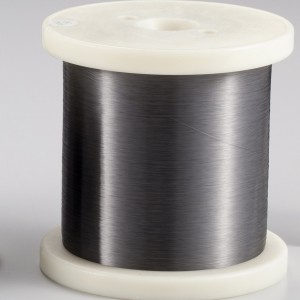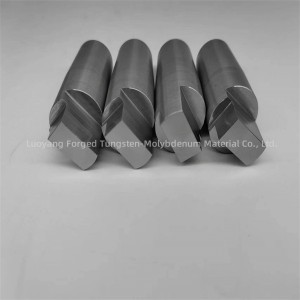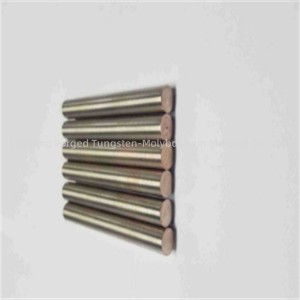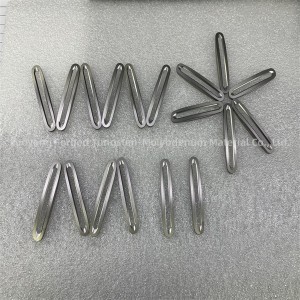Molybdenum electrode high temperature oxidation resistance, long service life
(1) Molybdenum powder with particle size ranging from 2.5um to 4.4um and oxygen content ranging from 400ppm to 600ppm is pressed into molybdenum billets. Then, the molybdenum billets are placed in a resistance sintering furnace and pre sintered under vacuum or hydrogen gas as a protective atmosphere. The pre sintering process involves first raising the temperature from room temperature for 4-6 hours to 1200 ℃, holding it for 2 hours, and then raising the temperature from 1200 ℃ for 1-2 hours to 1350 ℃, holding it for 2-4 hours;
(2) Place the pre sintered molybdenum billet in step (1) in a medium frequency induction furnace and sinter it under hydrogen gas as a protective atmosphere to obtain molybdenum electrodes with a quality purity of over 99.99%. The sintering process is as follows: first, heat up and sinter from room temperature for 1-2 hours to 1500 ℃, keep it warm for 1-2 hours, then heat up and sinter from 1500 ℃ for 1-2 hours to 1750 ℃, keep it warm for 2-4 hours, and then heat up and sinter from 1750 ℃ for 1-2 hours to 1800 ℃ to 1950 ℃, Keep warm for 4-6 hours.
Molybdenum electrode is a molybdenum electrode material that utilizes its unique advantages, temperature resistance, continuous surface, good conductivity, stable edges, and excellent corrosion resistance to improve its overall quality and service life. The molybdenum electrode has a silver gray metallic luster. This is a variety of forged intermediate frequency furnaces after isostatic pressing sintering, which are then rotated, rolled, planned, and ground.
The application of molybdenum electrodes in glass kilns is one of the reasons that affects their service life, which can be attributed to the following factors. Firstly, the insertion method of the electrodes, such as the top inserted electrode without electrode bricks, can improve the service life of the kiln, but it is easy to form a hot top, and the electrodes are prone to breakage, which requires high requirements for the shape of the material surface. The bottom inserted electrode has less corrosiveness, but requires higher design and equipment requirements. The erosion of flat electrode bricks is relatively high. If special protection measures are not taken, it will increase the erosion of the kiln and have high requirements for operation and use.
The second is to use the molybdenum electrode water jacket correctly. The electrode water jacket with bottom inserted electrodes is difficult to replace, so serious water leakage often occurs, leading to furnace shutdown. Therefore, it is necessary to regularly inspect and maintain the water jacket and softened water. In addition, the impurities and density of molybdenum electrodes also have a certain impact on the quality of kilns and glass. The proportion of impurities in molybdenum electrodes and the density and uniformity of molybdenum electrodes are important indicators for measuring molybdenum electrodes. Molybdenum electrodes with fewer impurities can produce glass with better transparency. In addition, excessive impurities of iron and nickel in the electrode can also affect the lifespan of the electrode. The electrode density is relatively high and uniform, which can not only improve the service life of the electrode, prevent electrode erosion, and cause a large amount of molybdenum particles to mix into the glass, but also effectively improve the performance of the glass.
In summary, molybdenum electrodes are mainly used in the manufacturing of glass and rare earth industries.
| Product Name | Molybdenum electrode |
| Material | Mo1 |
| Specification | Customized |
| Surface | Black skin, alkali washed, polished. |
| Technique | Sintering process, machining |
| Meltng point | 2600℃ |
| Density | 10.2g/cm3 |
Wechat:15138768150
WhatsApp: +86 15236256690
E-mail : jiajia@forgedmoly.com














